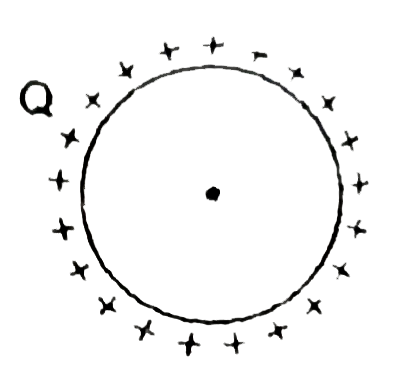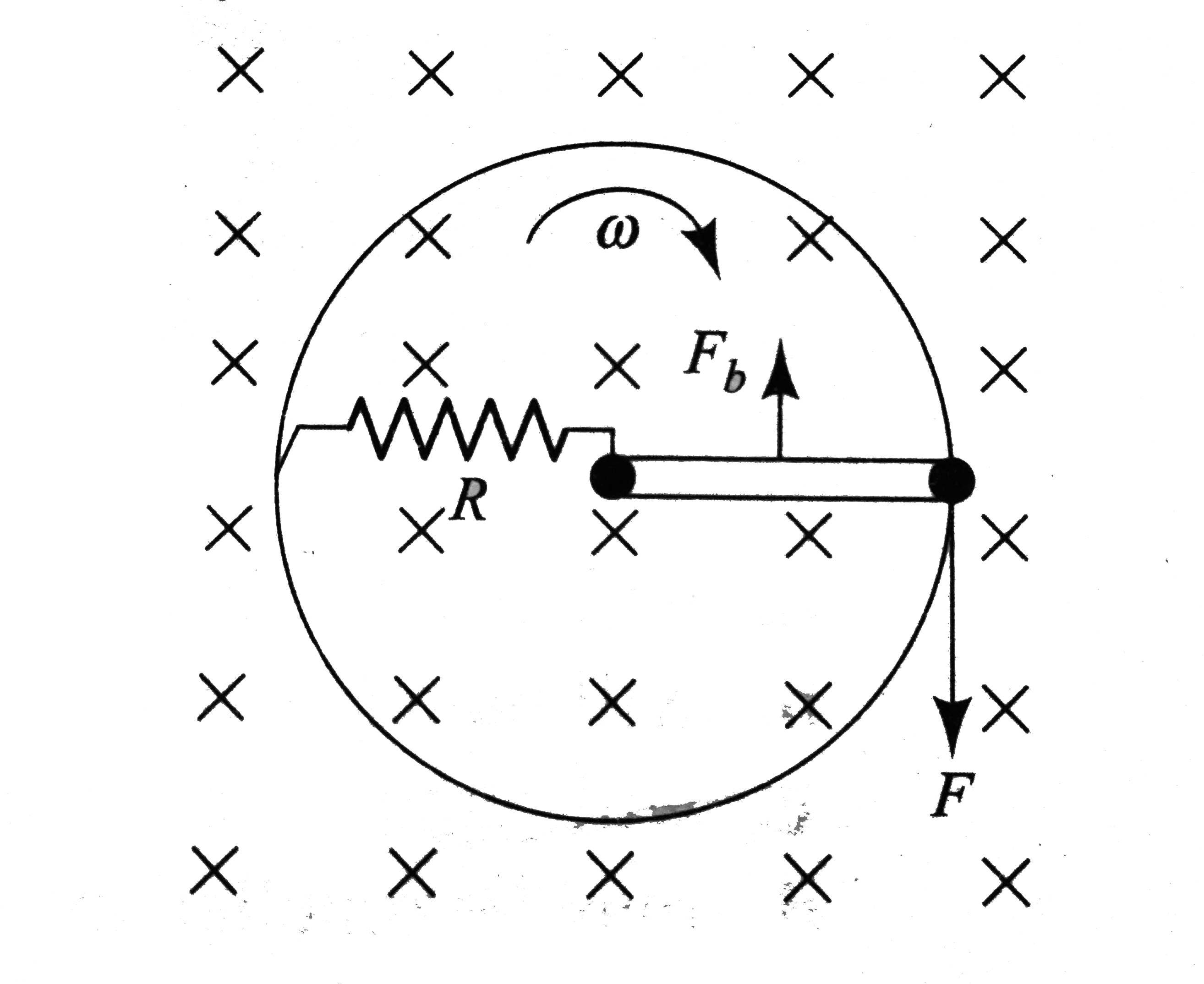Charge Q is uniformaly distributed on a thin insulating ring of mass m which is initially at rest. To what angular velocity will the ring be accelerated when a magnetic field B, perpendicular to the plane of the ring, is switched on ?
(a) QB2m
(b) 3QB2m
( c) QBm
(d) QB4m
The correct Answer is:A
(a) In accordance with Faraday's law of electromagnetic induction, the changing magnetic field induces an electric field in the ring. Let us imagine the ring to be diveded into differential elements of length ds and denote the tangential component of the induced electric field by Et. The change on element ds of the ring is dQ=Qds2πr, where r is the radius of teh ring . The force extered on it is dFt=dQEt, and the resultant torque is dtau=rdFt.
Thus, the torque experienced by the ring is
tay=∫dtau=∫rQds2πrEt=Q2π∫Etds ltbr> The induced electromotive force along the ring is directly proportional to the rate of change in the magnetic flux, we have
∫Etds=dΦdt=πr2dBdt
As a result of the torque, the ring, which has a moment of inertia I=mr2, starts to spin with angular accelaration α. During a time interval dt its angular velocity changes by
dω=αdt=τIdt=Q2π(πr2dBdt)1mr2dt=Q2mdB
Since the magnetic field strength increasing from zero to B, the final angular velocity of the ring will be
ω=(QB/2m)
→ The final angular velocity does not depend on the radius of the ring, the time over which the magnetic flux changes, or even on how the magnetic flux increases with time.
→ In our calculation we ignored the magnetic field produced by the ritating ring.
→ Except in the case of a cylindrical sysmmetric unitform field, it is not possible to find the actual value of the induced electric field within the ring because the geometric structure of the magnetic field is unknown an we do not know the position of the ring in the magnetic fiels. We can determine the total induced electromotive force, but not the eldtric field itself.
Topper's Solved these Questions
- ELECTROMAGNETIC INDUCTIONBOOK - CENGAGE PHYSICSCHAPTER - ELECTROMAGNETIC INDUCTIONEXERCISE - Exercises Multiple Correct
23 Videos
- ELECTROMAGNETIC INDUCTIONBOOK - CENGAGE PHYSICSCHAPTER - ELECTROMAGNETIC INDUCTIONEXERCISE - Exercises Asserton - Reasoning
8 Videos
- ELECTROMAGNETIC INDUCTIONBOOK - CENGAGE PHYSICSCHAPTER - ELECTROMAGNETIC INDUCTIONEXERCISE - Exercises Subjective
13 Videos
- ELECTROMAGENTIC INDUCTIONBOOK - CENGAGE PHYSICSCHAPTER - ELECTROMAGENTIC INDUCTIONEXERCISE - QUESTION BANK
40 Videos
- ELECTRON,PHONTS,PHOTOELECTRIC EFFECT & X-RAYSBOOK - CENGAGE PHYSICSCHAPTER - ELECTRON,PHONTS,PHOTOELECTRIC EFFECT & X-RAYSEXERCISE - dpp 3.3
15 Videos
Similar Questions
A conducting ring of radius r having charge q is rotating with angular velocity ω about its axes. Find the magnetic field at the centre of the ring.

View SolutionElectric charge Q is uniformly distributed around a thin ring of radius a. find the potential a point P on the axis of the ring at a distance x from the centre of the ring .

View Solution
Knowledge Check
Charge Q is uniformly distributed on the rim of a thin insulating disc of mass m which is initially at rest and placed on a smooth horizontal surface. What will be the angular velocity of the disc if a magnetic field B, perpendicular to the plane of the disc is switched on ?
 AQB/2mBQB/3mC2QB/3mDQB/m
AQB/2mBQB/3mC2QB/3mDQB/mCharges q is uniformly distributed over a thin half ring of radius R. The electric field at the centre of the ring is
Aq2π2ε0R2Bq4π2ε0R2Cq4πε0R2Dq2πε0R2A metallic ring of radius r with a uniform metallic spoke of negligible mass and length r is rotated about its axis with angular velocity ω in a perpendicular uniform magnetic field B as shown in Fig. 3.163. The central end of the spoke is connected to the rim of the wheel through a resistor R as shown. The resistor does not rotate, its one end is always at the center of the ring and the other end is always in as shown is needed to maintain constant angular velocity of the wheel. F is equal to (the ring and the spoke has zero resistance)
 AB2ωr28RBB2ωr22RCB2ωr32RDB2ωr34R
AB2ωr28RBB2ωr22RCB2ωr32RDB2ωr34R
Charge is uniformly distributed around a ring of radius R = 4.60 cm, and the resulting electric field magnitude R is measured along the ring's central axis (perpendicular to the plane of the ring). At what distance from the ring's center is E maximum ?
View SolutionA ring of mass m and radius R is given a charge q. It is then rotated about its axis with angular velocity ω.Find
(ii) Magnetic field produced at the centre of ring.
View SolutionA conducting ring is placed in a uniform magnetic field with its plane perpendicular to the field . An emf is induced in the ring if
View SolutionA positive charge Q is uniformly distributed along a circular ring of radius. A small test charge q is placed at the centre of the ring. Then A. If q>0 and is displaced away from the centre in the plane of the ring., it will be pushed bactowards the centre.
B. If q<0 and is displced away from the centre in the plane of the ring, it will never return no the centre and will continue moving til it hits the ring.
C. If q<0, it will performe SHM for small displacement along the axis.
D. Q at the centre of the ring is in an unstable equilibrium within the plane of the ring for q>0
View SolutionA charge q is unifomly distrybuted over a nonconducting ring of radius R. The ring is rotated about an axis passing through its centre and perpendicular to the plane of the ring with frequency f. The ratio of electric potential to the magnetic field at the centre of the ring depends on.
View Solution
